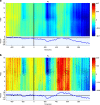Event-related potential data from a guess the number brain-computer interface experiment on school children
- PMID: 28350376
- PMCID: PMC5369320
- DOI: 10.1038/sdata.2016.121
Event-related potential data from a guess the number brain-computer interface experiment on school children
Abstract
Guess the number is a simple P300-based brain-computer interface experiment. Its aim is to ask the measured participant to pick a number between 1 and 9. Then, he or she is exposed to corresponding visual stimuli and experimenters try to guess the number thought while they are observing event-related potential waveforms on-line. 250 school-age children participated in the experiments that were carried out in elementary and secondary schools in the Czech Republic. Electroencephalographic data from three EEG channels (Fz, Cz, Pz) and stimuli markers were stored. Additional metadata about the participants were collected (gender, age, laterality, the number thought by the participant, the guess of the experimenters, and various interesting additional information). Consequently, we offer the largest publicly available odd-ball paradigm collection of datasets to neuroscientific and brain-computer interface community.
Conflict of interest statement
The authors declare no competing financial interests.
Figures




Dataset described in
-
Event-related potential datasets based on a three-stimulus paradigm.Gigascience. 2014 Dec 12;3(1):35. doi: 10.1186/2047-217X-3-35. eCollection 2014. Gigascience. 2014. PMID: 25671095 Free PMC article.
References
Data Citations
-
- Mouček R., Vařeka L., Prokop T., Štebeták J., Brůha P. 2016. EEG/ERP Portal (EEGbase), Experiments package: PROJECT DAYS P3 NUMBERS. https://eegdatabase.kiv.zcu.cz
References
-
- Farwell L. A. & Donchin E. Talking off the top of your head: toward a mental prosthesis utilizing event-related brain potentials. Electroencephalography and Clinical Neurophysiology 70, 510–523 (1988). - PubMed
-
- Fazel-Rezai R. et al. P300 brain computer interface: current challenges and emerging trends. Frontiers in Neuroengineering 5, http://journal.frontiersin.org/article/10.3389/fneng.2012.00014/full (2012). - DOI - PMC - PubMed
-
- Blankertz B. et al. The bci competition 2003: progress and perspectives in detection and discrimination of eeg single trials. IEEE transactions on biomedical engineering 51, 1044–1051 (2004). - PubMed
-
- Hoffmann U., Vesin J.-M., Ebrahimi T. & Diserens K. An efficient p300-based brain-computer interface for disabled subjects. Journal of Neuroscience Methods 167, 115–125 (2008). - PubMed
Publication types
MeSH terms
LinkOut - more resources
Full Text Sources
Other Literature Sources
Miscellaneous

